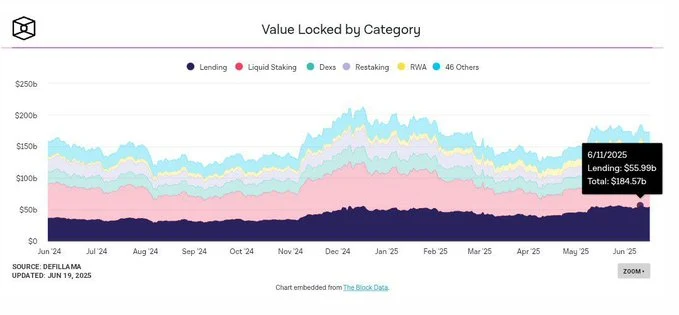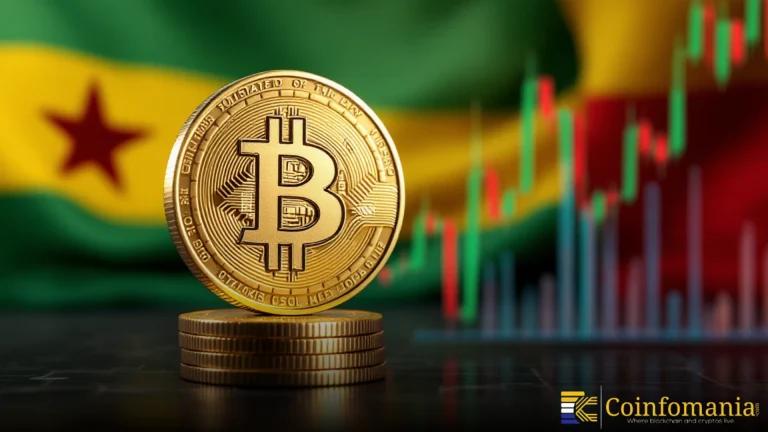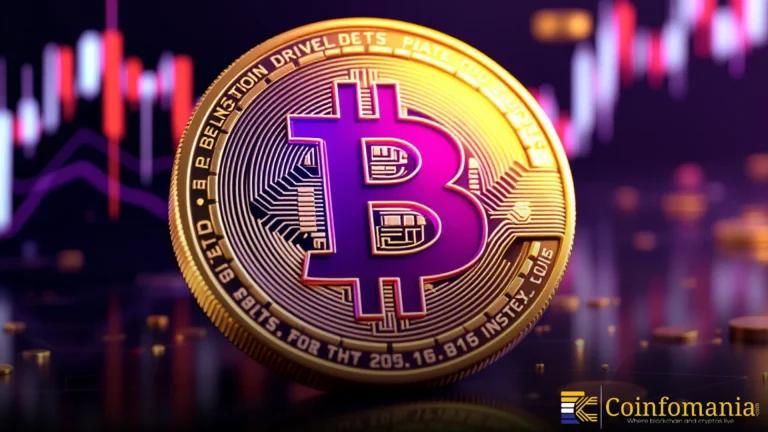DeFi Lending Surges as Total Value Locked Hits Record $55.99B
DeFi lending hits a record $55.99B TVL, with Aave, Morpho Blue, and Maple leading the charge in the new credit cycle.

Quick Take
Summary is AI generated, newsroom reviewed.
DeFi lending reaches a record $55.99B TVL, with Aave and other platforms driving significant growth.
The introduction of RWAs, tokenized debt, and sovereign pools is transforming the DeFi landscape.
DeFi is establishing a new credit cycle fully on-chain, challenging traditional financial systems with decentralization.
As of 20 June, the total value locked (TVL) reached a new high of 55.99 billion as Decentralized finance (DeFi) lending is back in full swing. This number is even more than the hype in 2021, the 2022 comeback, and the late 2024 rally. This unprecedented development has been caused by DeFi attracting widespread attention. Further, more users and liquidity are pouring into decentralized lending platforms.
One of the most well-established platforms in the area, Aave v3, has a TVL of 26 billion now. It has recorded over $1.6 million in daily fees, which is a clear indication of gaining a sector of interest in the DeFi lending industry. The AAVE token alone has gained 65% within a span of three months, with the growing confidence in DeFi protocols. Such a phenomenal increase in TVL shows that decentralized finance has become a common financial alternative. Moreover, significant liquidity is entering DeFi lending and staking.
Additionally, smaller platforms as Morpho Blue and Maple are making inroads under the radar. Morpho Blue has locked up $3.9 billion TVL, which is a 38% growth year-to-date. Maple is seeing explosive growth, reaching a TVL of $1.37 billion with a greater than 140% growth in the SYRUP token since May. The trend indicates that even minor innovative platforms are performing well. Often, this leads to the expansion of the DeFi sector in general.
The Changing Landscape of DeFi: From RWAs to Tokenized Debt
The DeFi lending is developing at a very fast pace. The future of decentralized finance is being formed with the introduction of Real-World Assets (RWAs), tokenized debts, and sovereign pools. The move towards RWAs and the tokenization of debt is a large step that can bring desperately needed liquidity to support the decentralised lending platforms.
Such transformation also expands the opportunities of letting the traditional financial institutions connect to DeFi. Additionally, it fills the gap between the traditional financial system and decentralized finance world. Another thriving sector within DeFi is sovereign pools, which are becoming enough to provide a decentralized loan framework. This is often in the manner of a bank mortgage system with decentralization and more transparency.
With the maturity of the DeFi lending sector, the new mechanisms are expected to result in new implementations and expansions in adoption. They also demonstrate that the market has now grown into an operational work and that it has long-term sustainability.
The Rise of a New Credit Cycle: DeFi Fully On-Chain
What we are observing is the advent of a new credit cycle, and everything is taking place on-chain. The centralized structures of the traditional credit markets have suffered a challenge with DeFi issuing decentralized derivations that are safe, transparent and accessible to all people who have access to the internet.

Using the numbers on the chart, the trend of DeFi is quite obvious, as lending is on an upward trend and in the lead in the market. The total value locked in the DeFi lending sites is constantly accelerating. Moreover, the increase in the number of assets and liquidity being received signals that the credit market may undergo a boom in decentralization. The trend reveals that the lending industry will have grown tremendously by June 2025, with lending platforms taking up the industry.
The change matters due to increased maturity in DeFi. It is no longer a dream market but a valid component in the global financial system. DeFi will keep expanding, and, as a result, the infrastructure of the market will build up even more, aiming at the attraction of institutional investors and the traditional players of the financial industry.
Follow us on Google News
Get the latest crypto insights and updates.


